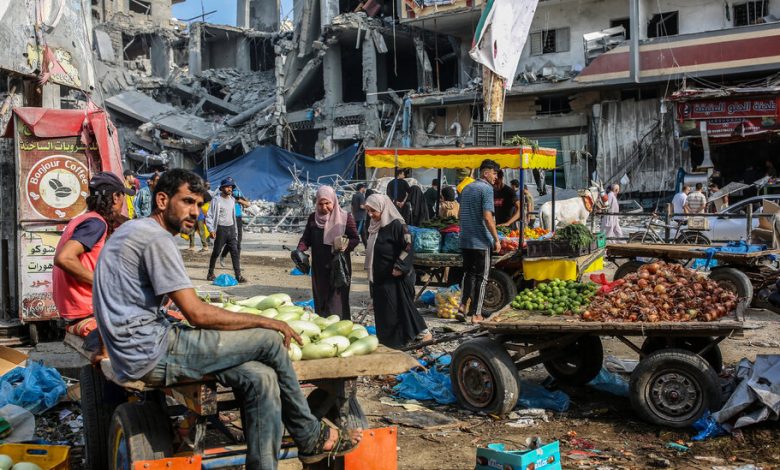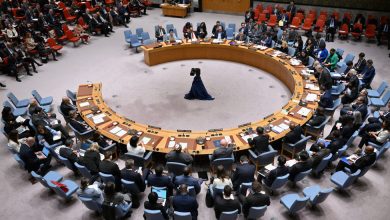As Bombs Fall in Gaza, History Hangs Over a Family Fighting to Survive

Mohammed Abujayyab was at his wits end.
For six days he has been stuck inside his Los Angeles apartment, sleep-deprived and anxious, glued to the television and jabbing messages into his phone. The 39-year-old software engineer was trying to save his grandmother, who was thousands of miles away in Gaza. But she wasn’t listening to his pleas to flee.
By then, Israeli warplanes had already dropped 6,000 bombs on Gaza in response to the devastating Hamas attacks of Oct 7. Entire neighborhoods had been leveled in Gaza, and the reported death toll was rising by the hundreds every day. Israel had just ordered more than a million residents to immediately abandon their homes in the northern part of Gaza and move to the south.
In frantic conversations on a family WhatsApp group, Mr. Abujayyab urged his 88-year-old grandmother, Rifa’a, to join the exodus of residents — even if dozens had died in blasts along the route. (Hamas blamed Israel, which denied responsibility.) But she refused to go.

Mohammed Abujayyab in his apartment in the East Hollywood section of Los Angeles on Friday.Credit…David Butow for The New York Times
His grandmother had already fled once, he explained, in 1948, as one of 700,000 Palestinians who fled or were expelled from their homes during the war that followed the creation of Israel. She ended up in Gaza, the crowded coastal strip, where she spent most of her life under Israeli occupation and control. Seventy-five years later, she had no intention of running again.
“She went through 1948,” a bleary-eyed Mr. Abujayyab said in a video call. “She heard a warning that if she leaves, she won’t be able to get back. She said it was better to stay and die in her house.”
‘The identity card in your head’
History informs everything in Gaza, especially at its most desperate moments. For over a century, the tiny strip of dusty land, at the hinge between the Middle East and Africa, has been controlled, often reluctantly, by different powers: first the Ottoman Empire, then Britain, Egypt and, most consequentially, Israel.
Since 2007, Gaza has been ruled by Hamas, the Islamist political and military organization — although Israel controls its borders through a punishing blockade that is also enforced by Egypt.
But for its people, Gaza is defined by displacement. About 80 percent of its 2.1 million inhabitants are registered refugees — Palestinians forced out of present-day Israel in 1948, or, for the most part, their descendants. That trauma is at the center of their identity, said Azmi Keshawi, a Gaza researcher with Crisis Group, a research organization.
“If you ask a 10-year old boy where he is from, he will tell you the name of their village, its history, their land,” Mr. Keshawi said. “This is the education that passes from the grandfather to father to son. The majority of refugees in Gaza still have the keys, and the papers, to their old homes. And there is an expectation that one day we will go back.”
The prospect of a Palestinian return to that land seems vanishingly small. In the past, even leaders of Hamas have hinted they might compromise on that issue. But many Gazans cling to their identity of displacement in spite of, or because of, the suffocating 16-year blockade.
“It’s the identity card in your head,” Mr. Abujayyab said.
As Israel prepares for an expected ground invasion of Gaza, many fear that history is about to be repeated. Prime Minister Benjamin Netanyahu has said he needs to clear Gazans from their homes for the duration of fighting to “eliminate” Hamas. Many Gazans fear they will never be allowed back, and that the invasion is a pretext to force them out, possibly into Egypt’s Sinai Peninsula, for good.
“My parents and I are not going to repeat the mistake of the Nakba,” Bayan Abusultan, a 27-year-old journalist from Gaza, said this month on social media. (The Nakba, or “catastrophe,” is how Palestinians describe the events of 1948.)
In a video posted to Instagram, a Gazan man whose home was bombed expressed a similar defiance. Asked if he is ready to take refuge in Sinai, he replies, “Of course not.”
“We are not going to be displaced a second time,” he says. “Enough what happened to our grandfathers and fathers, who were forcibly displaced.”
He adds, “I’d rather die than move.”
Rising frustration and fences
Gaza wasn’t always at war. There was no fence in the first decades after Israel defeated Egypt and other attacking countries in a 1967 war, seizing Gaza. Sara Roy, a scholar on Gaza at Harvard, remembered the entry barrier in the 1980s: A lone soldier standing over a concrete-filled drum who offered a desultory wave to Gazans as they passed, she said.
Israeli leaders tried to quell Palestinian demands for self-determination by offering economic opportunity. Gazans were permitted to travel freely inside Israel, where tens of thousands worked, mostly as day laborers, including many of Mr. Abujayyab’s relatives. “You could drive to Tel Aviv or Jaffa for the day,” he said.
Still, frustration grew. The first intifada, or Palestinian uprising, in 1987, started with a traffic accident in Gaza, when a military truck plowed into a vehicle carrying Palestinian workers. As anti-occupation strikes and protests swelled, Israel restricted movement from Gaza. A fence, modest at first, began to rise.
“I would like Gaza to sink into the sea,” said Yitzhak Rabin in 1992 when he was Israel’s prime minister. But since that was unlikely, Mr. Rabin added, a solution had to be found. A year later he shook hands with the Palestinian leader Yasir Arafat on the White House lawn, to seal the first of the Oslo peace accords. Many Palestinians saw it as a major step toward their own state.
Sharing in that optimism, Mr. Abujayyab’s family moved back from Saudi Arabia, where his parents had been teachers, and returned to Maghazi, a crowded refugee camp in central Gaza. Mr. Abujayyab, then 10, enrolled in a United Nations school.
“We imagined we would become doctors and engineers,” he said.
But during his final year in high school, in 2000, a second intifada erupted. Palestinian suicide bombers struck cafes, hotels and buses in Israeli cities, often prompting brutal security crackdowns. Mr. Abujayyab joined protests where students threw stones at Israeli military convoys.
“It felt like a meager response,” he said. “Like we were bringing a knife to a gunfight.”
One of his friends was killed near the fence. But Mr. Abujayyab got out, winning a scholarship to study engineering in the United Arab Emirates. In 2007 he emigrated to the United States, where he later became a citizen.
That was also a consequential year for Gaza.
Two years earlier, in 2005, Israel, under occasional rocket fire from Hamas, had pulled its soldiers and about 9,000 settlers out of Gaza. Israeli leaders made hopeful pronouncements that Gaza could become the “Hong Kong of the Middle East.”
But the Israeli authorities maintained a hold on Gaza, controlling its port, airport and much of its economy, as well as residents’ movements. Hamas, considered a terrorist group by the United States and the European Union, won Palestinian legislative elections in 2006. A year later, it violently ejected its main rivalfrom Gaza and established total control over the territory.
Israel’s restrictions morphed into a suffocating blockade, enacted with Egypt’s help. The security fence grew higher and more elaborate. Mr. Abujayyab began to hear about autonomous guns that opened fire if people got too close.
“The fence became this bigger and bigger barrier that felt, from 2007 onward, like a prison,” he said.
Lives consumed by conflict
In the United States, Mr. Abujayyab got married and divorced, and moved from New York to Utah to California, where he worked for a large software company. He liked Los Angeles for its warm climate and a line of fig trees in Beverly Hills that reminded him of home.
He visited Gaza in between wars.
Gaza was consumed by battles between Israel’s military and Hamas fighters in 2008, 2012, 2014 and 2021. The death toll was hugely skewed — about 5,600 Gazans had been killed in conflicts by 2020, and about 250 Israelis — yet the blockade seemed ineffective: Hamas continued to launch rockets into Israel.
Israeli leaders justified their harsh policies, including the blockade, as a necessary measure to stop attackers infiltrating from Gaza. Military analysts spoke of “mowing the grass” — periodic assaults on Gaza. Human Rights Watch has said those policies amounted to “crimes of apartheid and persecution,” and the United Nations said the blockade in particular amounted to collective punishment.
For ordinary citizens, life became unbearable. By 2015, the economy had halved in size and youth unemployment reached 60 percent. On average 4,000 people were allowed to exit Gaza every month, compared to as many as 500,000 per month before 2000. Psychiatrists reported a high incidence of mental illness, especially among women and children. Young men, lacking work and the means to get married, grew frustrated. Prostitution and drug abuse, previously rare in Gaza, became more common.
Hamas, meanwhile, prepared for the next war — digging tunnels, smuggling weapons and training fighters.
They were not the only source of resistance. Civil society groups led major protests to “break the siege” at the security fence in 2018. Israeli forces opened fire on protesters who threw stones and cut the fence, killing 183 people and injuring 23,300, a U.N inquiry found.
Mr. Abujayyab became a food activist, helping to set up a farm in the West Bank and a wheat mill in Jordan. He was stranded in the West Bank for a year in 2015, forbidden from leaving by Israeli officials until his U.S. citizenship helped him leave.
As conditions worsened, he decided to get the rest of his family out. Artillery pounded Maghazi during the 2014 war, forcing his family to evacuate for seven weeks. Two years later, his parents emigrated to the United States.
Trump-era restrictions and the coronavirus pandemic delayed further departures. But in the past year, he paid for air tickets for three of his brothers, who reached Norway, Brazil and the United States.
Still, one sibling remained behind.
‘The world has gone insane’
When Mr. Abujayyab first learned of the Oct. 7 Hamas attacks, on Instagram, he said he was astonished by what he saw.
Israeli and Western news coverage focused on the mass violence against Israeli civilians: Young people gunned down at a music festival and entire families shot dead inside their homes. By the end of the day, more than 1,400 civilians and soldiers were dead, Israeli officials said.
But Arab TV channels and news sites prioritized images of Hamas militants breaking down the security fence around Gaza with bulldozers, and storming through the main crossing point with Israel, a cavernous building bristling with scanners and security equipment that is detested by many Gaza residents.
When Mr. Abujayyab saw those images, “it was one of the most satisfying moments of my life,” he said. “I saw grandparents live and die in a refugee camp, and never get out,” he said. “So when I saw someone bulldoze that fence, it felt like we had broken out of prison.”
That sense of satisfaction quickly evaporated, though, as Israel warplanes began to pulverize targets inside Gaza. As it became clear that the bombing was far more intense, and deadly, than anything that had come before, Mr. Abujayyab began to worry for his sister, Doaa, 26, a computer science graduate who had been waiting for an immigration interview for the United States.
His sister communicated by voice notes, usually sent to a WhatsApp group that included family in Egypt, Norway, Brazil, the United Arab Emirates and the United States. Doaa tried to remain claim, but in the background explosions could be heard. At her family’s urging, she moved to their grandmother’s apartmenton the west side of Gaza, bordering the Mediterranean.
For the first two days, Mr. Abujayyab didn’t sleep. He monitored television and social media for useful information and consulted with family members. As bombs rained on Gaza and the death toll soared, his desperation grew. Relatives sent messages asking for forgiveness — a sign they were preparing to die.
“That’s the hardest thing to hear,” he said. “They don’t know what to do. They have no place to go. The world has gone insane.”
Israeli soldiers scrambled to repair the broken fence around Gaza, but the gulfs between ordinary Palestinians and Israelis had already widened to new extremes. Mr. Abujayyab viewed grisly accounts of atrocities by Hamas as Israeli propaganda. He was disillusioned by President Biden’s claim to have seen pictures of beheaded babies, which the White House later walked back.
“All of this is drumming up a pretext for genocide,” he said. In Israel, a member of Mr. Netanyahu’s party urged a “Nakba that will overshadow the Nakba of 1948.”
The legacy of displacement also loomed large inside Israel, said Nathan Thrall, author of “A Day in the Life of Abed Salama,” a book about the lives of Palestinians and Israelis. “Beyond the shock and atrocities of the attack, it played to the deepest Israeli fears — that all these Palestinians, who live on the other side of the wall, are going to come back and try to retake their villages and homes,” he said.
On the fifth day of the war, Mr. Abujayyab received devastating news. An Israeli airstrike had crushed an apartment block in the Jabaliya refugee camp, in northern Gaza, killing 45 members of his extended family. The dead included a month-old boy.
“I consider myself a tough person,” Mr. Abujayyab said in a video call the next day, his eyes welling up. “But I had to take a moment and cry it out.”
A split developed inside the family WhatsApp group. His grandmother was still defying the Israeli order to evacuate, even though Israel’s military would soon warn that residents who stayed risked being considered a “a member of a terrorist organization.”
But his sister, Doaa, was less sure. Mr. Abujayyab and his siblings argued about her next move: Stay at her grandmother’s apartment? Or risk the short but dangerous journey south?
Even below the evacuation line, nobody was safe. Mr. Azmi, the Crisis Group researcher, had moved his family to a friend’s house in southern Gaza. On Saturday an airstrike hit next door, collapsing the roof on top of his 29-year-old son. It fractured his skull and crushed his chest, Mr. Azmi said by phone. But he survived.
Then Mr. Abujayyab’s grandmother had a close call. Early Friday, the Israeli military ordered the residents in a cluster of 25 apartment blocks near his grandmother, to evacuate. A small drone strike on a rooftop reinforced the message.
Soon after, jets bombed the apartments, blowing out his grandmother’s windows. With his sister, she took off into the night with about 6,000 other people, sleeping on the roadside. Eventually they found shelter at a small hospital run by a relative in southern Gaza.
By Tuesday, the Israeli assault had killed 5,700 people in Gaza, according to the Hamas-runHealth Ministry in the territory.
The night before, two other grandmothers got out of Gaza: Nurit Cooper, 79, and Yocheved Lifshitz, 85, who had been kidnapped on Oct. 7 during a massacre at Kibbutz Nir Oz, barely a mile from the fence. Hamas released the two women through Egypt. But their husbands, and more than 200 other captives, remained in Gaza.
Mr. Abujayyab’s sister or grandmother likely didn’t hear that news. They had no power, limited internet and more bombs were falling, his sister said in a voice message to her family.
“There are many reasons you can’t reach us,” she said. “Don’t worry.”
Lila Hassan, Abu Bakr Bashir and Yousur Al-Hlou contributed reporting



